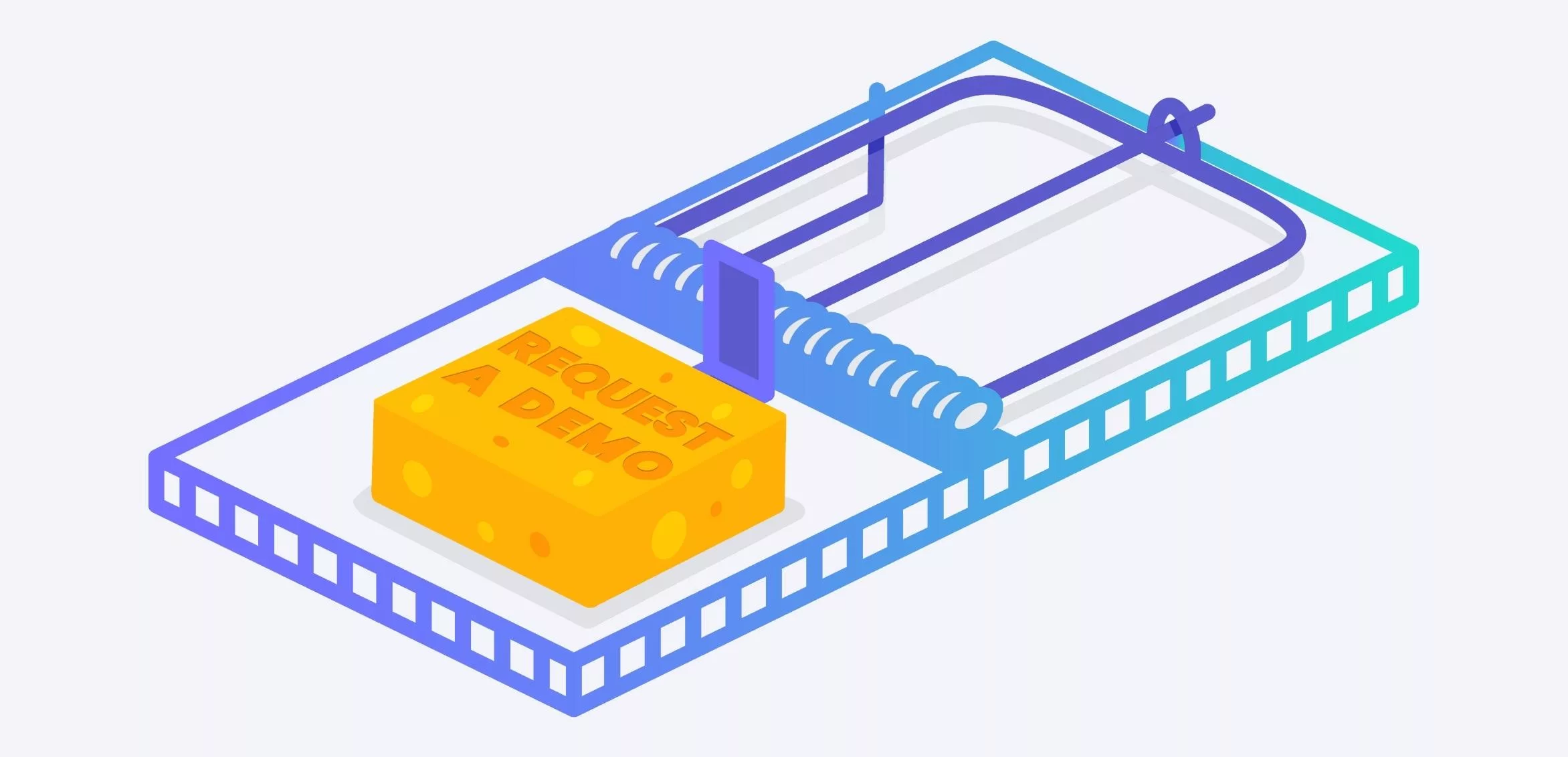Accelerate deals and increase win rates with the leading enterprise demo platform.
Death to the Bait & Switch B2B Demo Request

February 12, 2025
Table of Contents
Ah, the wonderful world of B2B SaaS websites. Tell me if this journey sounds familiar.
You find a solution that looks lovely, looks innovative and looks like it might solve a problem you have. Jackpot.
But first, you want to see how it works for yourself.
So you click that big beautiful button in the middle of the page—”Request a Demo.”
And what do you get?
A whole bunch of annoyances that are definitely not a product demo. And a much less effective sales process for everyone involved.
The Classic Demo Bait and Switch
Clicking that oh-so-tempting button probably means you’ll be in for a call from a BDR asking you basic discovery questions. Then they’ll let you book a “demo,” which is another call with an AE repeating those same questions but unable to answer any of yours about the product.
And finally, they’ll let you actually book a demo of their software, which is what you thought you were doing when you clicked that button. Two whole weeks later, you get on a call with an SE who can give you the technical details you need to make a decision.
By then, you’re over the whole process. You’ve checked out competitors, done a ton of online research on your own, and talked to your network. You’re going to buy another product from a company that makes the whole purchase process easier—after all, aren’t they trying to get you to give them money? Why are they making this so hard?
And it’s not the BDR or AE’s fault here at all—they’re being set up to fail by the verbiage their marketing team put on the site, and the outdated playbook the sales leader is still using.
What the Bait and Switch Product Demo Costs You
I’m a writer—I believe that words have meaning. If you’re not going to give people a demo when they click a button that offers them one, that’s poor marketing practice.
And it lowers the trust the prospect has in your company right off the bat, which is not where you want to start the sales process. Closing a deal requires gaining the trust of your buyer, especially in the B2B world where contracts run months or years and cost tens of thousands of dollars.
If you begin the relationship with a customer by not delivering what you promised them, why should they believe anything else you say in the sales process?
Not to mention, with such fierce competition it’s a miracle they even landed on your website to request a demo. You successfully broke through all the noise and now have a chance to seal the deal. That’s some of the hardest work right there. Leaving them hanging is just adding insult to injury!
Plus, SaaS buyers today are not the SaaS buyers of a decade ago. They’re mostly very informed and educated—many of them know exactly what they want before they even talk to a sales rep, and a few might even have used your product before. They do their own research and they’re impatient with the traditional “give to get” sales playbook.
Pulling the old bait and switch on these super-informed buyers is going to annoy them. (If it’s happened to you, you know the feeling!) And it makes the B2B buying process what it is today—77% of buyers find it extremely difficult or complex, according to Gartner.
Only 5% of a customer’s time is spent with a sales rep in the whole B2B buying journey. Your chat with the buyer during that initial call might be the only time you ever get with them—so you need to get it right.
Delivering the Right Product Demo
Sure, you can find a lot of justifications for these kinds of practices:
- Buyers don’t know what they need, so we have to educate them our way.
- We can’t give a demo without knowing something about the prospect, so we need that discovery step.
- Our SEs are getting pulled into too many unqualified demos, so we’re trying to be careful about their time.
- We don’t have a solution to keep up with the demand; we’d need to hire more help which isn’t scalable.
And you know what—these are all real problems.
They’re just not solved with marketing that promises one thing and delivers something else.
Let’s break it down.
Buyers don’t know what they need
Well, pulling them into a sales call they didn’t choose with a BDR who can’t answer technical questions isn’t the way to educate them effectively. They’ll be too annoyed to properly listen.
Instead, focusing on marketing tools that deliver what they actually need to learn. Content marketing is powerful for this when it’s done right, providing value to your target audience in mind.
We can’t give a sales demo without discovery
Sure, knowing some basic things about your prospect makes your demos more effective. Sales reps can’t do their jobs when they go in blind. But the discovery process is changing, and sales and presales need to pivot.
For example, you’d never sell a car the way you sell B2B SaaS software. While having a lot of information upfront is helpful, expecting prospects to provide a whole deep dive just to get a glimpse of what you actually sell is increasingly outdated. Find another way to get that info.
Our Solutions Engineers get too many unqualified demo requests
This is a huge issue for the presales field right now and is one of the reasons SCs are so in demand. You do need to stop wasting their time on unqualified demos—but a sneaky switch isn’t the answer.
You can do this by creating interactive product tours on your website where customers can become familiar with your product before they even get on a call.
This helps to optimize discovery and shorten sales cycles by being able to tailor demos to a buyer’s identified needs because the buyer was able to experience your product already. Buyers can even disqualify themselves because maybe after seeing your tour, they realize they don’t really need a demo in the first place.
Scale with Reusable Interactive Demos
You can also use a demo creation platform to create a demo library of reusable interactive demos by industry, verticle, and use case that your AEs can pull from in that intro call.
Your AEs can then personalize this introductory pre-made demo with things like the prospect’s name, company name, and logo — all in just a couple of clicks.
Your prospect will be happy since you’ll deliver the promised demo (yay!), and your SEs will be pleased because they can wait to join the call when it’s a more mature demo.
Therefore, with demo creation software, you don’t need to hire a million SEs just to keep up with the increasing demand for demos.
You can scale the smart way by letting a demo platform do that upfront work so your SEs can focus on qualified prospects and bring their extensive expertise where it’s truly needed.
Bringing discovery and demo together is all possible when creating your demo on a demo creation platform that lets you responsively share your product with prospects during the call. This is much better than the traditional rigid demo.
With these solutions, your SEs won’t be swamped by first-call demo requests, and your prospects won’t feel like a fish that swallowed what looked like a tasty snack and found themselves on the hook instead.







